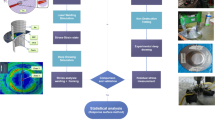Abstract
To attain the objective of minimizing the harmful movement of the weld joint in tailor-welded blanks (TWBs) forming, a novel optimization methodology based on dynamic explicit finite element simulation is presented to determine optimum contact forces. In this methodology, forming limit diagram (FLD) models developed for different types of TWBs are treated as a criterion of constraint in optimizations. Due to the highly nonlinear nature of the forming process, response surface methodology (RSM) is utilized to construct sequential response surfaces to approximately describe the objective the constraint functions and the optimum contact forces of TWBs stamping are obtained with some successive iterations. However, a large number of numerical simulation runs are needed for optimization with higher-order approximate models or many design variables. To improve the efficiency of optimization, the space mapping (SM) technique utilizing surrogate models is integrated with RSM. Two examples are used to validate this algorithm: one optimization for TWBs stamping with the same thickness but different materials, and the other optimization for TWBs stamping with the same material but different thicknesses. The results demonstrate that the method is efficient and effective in solving contact forces optimization problems.
Similar content being viewed by others
References
Kusuda H, Takasago T, Natsumi F (1999) Formability of tailored blanks. J Mater Process Technol 71:134–140
A/SP Tailor-Welded Blank Task Force (1995) Tailor-welded blank design and manufacturing manual. Auto/Steel Partnership, Tech Report, http://www.a-sp.org
Cao J, Kinsey BL, Yao H, Viswanathan V, Song N (2001) Next generation stamping dies - controllability and flexibility. Robot Comput-Integr Manuf 17:49–56
Reis Ana, Teixeira Pedro, Duarte J Ferreira, Santos Abel, da Rocha A Barata, Fernandes AA (2004) Tailored welded blanks - an experimental and numerical study in sheet metal forming on the effect of welding. Comput Struct 82:1435–1442
Venter Gerhard (2002) Non-dimensional response surfaces for structural optimization with uncertainty, PhD Thesis. University of Florida, USA
Leary SJ, Bhaskar A, Keane AJ (2001) A constraint mapping approach to the structural optimization of an expensive model using surrogates. Eng Optim 2:385–398
Zimniak Z (2000) Implementation of the forming limit stress diagram in FEM simulations. J Mater Proc Technol 106:261–266
Chan SM, Chan LC, Lee TC (2003) Tailor-welded blanks of different thickness ratios effects on forming limit diagrams. J Mater Proc Technol 132:95–101
Levy SB (1996) A comparison of empirical forming limit curves for low carbon steel with theoretical forming limit curves of Ramaekers and Bongaerts. IDDRG Working Group 3, Ungarn, pp 13–14
Dowling NE (1998) Mechanical behavior of materials: engineering methods for deformation, fracture, and fatigue, 2nd edn. Prentice Hall, New Jersey, USA, pp 565–566
Barlat F, Lege D, Brem J (1991) A six-component yield function for anisotropic materials. Int J Plast 7:693–712
Belytschko T, Ong S (1984) Hourglass control in linear an nonlinear problems. Comput Methods Appl Mech Eng 43:251–276
Driessen L, Brekelmans R, Hamers H, den Hertog D (2001) On D-optimality based trust regions for black-box optimization problems, discussion paper, No. 200169, Tilburg University, Netherlands
Søndergaard J (2003) Optimization using surrogate models - by the Space Mapping technique. PhD Thesis, Technical University of Denmark, Denmark
Boggs PT, Tolle Jon W (2000) Sequential quadratic programming for large-scale nonlinear optimization. J Comput Appl Math 124:123–137
Author information
Authors and Affiliations
Corresponding author
Rights and permissions
About this article
Cite this article
Zhang, J. Optimization of contact forces in tailor-welded blanks forming process. Int J Adv Manuf Technol 33, 460–468 (2007). https://doi.org/10.1007/s00170-006-0491-9
Received:
Accepted:
Published:
Issue Date:
DOI: https://doi.org/10.1007/s00170-006-0491-9




